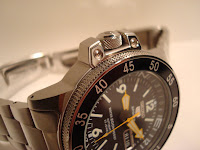This past December saw the arrival of a brand new bouncing baby Seiko "5". The Seiko SKZ211 a.k.a. the Atlas, a.k.a. the LandShark was one of those watches that caught my attention years ago and one that I couldn't get out of my mind. I don't know why I never got one except that I had just gotten the Seiko Diver's SKX007 and didn't want to overdo it on the Seikos. Since then I've learned that there is no such thing as overdoing it, especially with Seikos. Considering the price to quality ratio of most of the watches available today Seiko represents a super value. The Atlas is no exception. In fact, I was surprised at the quality of this watch. It's a solid watch with a stainless steel case, case back and bracelet. It's a relatively heavy watch that wears so comfortably that I often forget that it's there. And it has the serious look of a watch that does more than just tell the time.
 The five attributes of a Seiko "5" are (1) Automatic movement, (2) Water resistant, (3) Shock resistant, (4) Date display and (5) Day display.
The five attributes of a Seiko "5" are (1) Automatic movement, (2) Water resistant, (3) Shock resistant, (4) Date display and (5) Day display.One of the selling points is the rotating compass ring on the face of the watch. If you can locate the sun then you can determine your direction. It's actually very simple and once you get it you really don't even need the compass function anymore. But it's a neat feature to have and one that I'm going to test for real in the field someday. I would use it in conjunction with a map by placing it on the map after locating my north and orienting the map accordingly. No different from using a magnetic compass except that it requires your input. The advantage is that it cannot be influenced by other metallic or iron bearing objects which might throw off a magnetic compass. One of the two common complaints I've read about this feature is that the inner compass ring rotates too easily and the mere action of your arm moving is enough to cause the ring to spin. Well, it does. But, so what? You would reset the ring each time you double checked your heading anyway, wouldn't you? So that argument is pretty much moot. The other complaint is that using the sun for navigation isn't accurate enough or dependable. I guess before the invention of the magnetic compass everyone stayed home.
 Case: Stainless steel.
Case: Stainless steel.Bracelet: Stainless steel double folding safety clasp with push buttons.
Movement: Automatic, 7S36, 23 jewels.
Crystal: Hardlex
Dimensions: 40mm at bezel. 13mm thick. 48mm lug to lug.
 A nice view of the knurled bezel and the compass ring crown. Another "5" in case we missed the other two on the face and the back.
A nice view of the knurled bezel and the compass ring crown. Another "5" in case we missed the other two on the face and the back. 22mm lugs with drilled pin holes. The end links are indeed solid and do squeak a bit but that goes away after awhile.
22mm lugs with drilled pin holes. The end links are indeed solid and do squeak a bit but that goes away after awhile.The face is excellently laid out with illuminated "6", "9" and "12" hour markers in between illuminated stick indices. The use of a black date wheel framed in chrome is brilliant. And the icing on the cake are the yellow hour, minute and second hands. Irresistible.
The rotating outer bezel turns smoothly with 120 clicks per minute. The surface of the bezel is nicely knurled and very grippy. The look of this bezel is actually another one of the design elements that made me a fan of this watch.
The heart of this watch is the Seiko 7S36 movement which is essentially a slightly upgraded version of the Seiko 7S26 movement introduced in 1996. The 7S36 uses 23 jewels as opposed to the 21 jewels in the 7S26. The overall concensus is that the two additional jewels in the 7S36 don't really do anything except to allow Seiko to claim that it has two addition jewels. I can say however that the Atlas has kept amazingly good time (+2 secs/day) since I've gotten it as compared to the Seiko Diver 007 with the 7S26 which easily gains 15 secs./day. It's probably just hit or miss with these things. I don't think the extra two jewels have anything to do with it. Either way, the 7S family of movements is known for it's toughness and dependability.
All in all I'm a very happy camper with this watch. I would recommend it to others. It could very well turn out to be one of those quirky little watches that, after a relatively short production run, becomes the object of collector fascination.
and on another note
Tempest in a teapot in Switzerland:
Check out the following link to a blog called Perpetuelle.
It's just one of many sites chiming in on a subject that has the watch world abuzz. Somehow I missed it and I'm only finding out about it now. Basically, I have no problem with outsourcing movements, it's the lying about it that troubles me.












